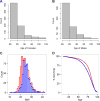Whole-Genome Sequencing of a Healthy Aging Cohort
- PMID: 27114037
- PMCID: PMC4860090
- DOI: 10.1016/j.cell.2016.03.022
Whole-Genome Sequencing of a Healthy Aging Cohort
Abstract
Studies of long-lived individuals have revealed few genetic mechanisms for protection against age-associated disease. Therefore, we pursued genome sequencing of a related phenotype-healthy aging-to understand the genetics of disease-free aging without medical intervention. In contrast with studies of exceptional longevity, usually focused on centenarians, healthy aging is not associated with known longevity variants, but is associated with reduced genetic susceptibility to Alzheimer and coronary artery disease. Additionally, healthy aging is not associated with a decreased rate of rare pathogenic variants, potentially indicating the presence of disease-resistance factors. In keeping with this possibility, we identify suggestive common and rare variant genetic associations implying that protection against cognitive decline is a genetic component of healthy aging. These findings, based on a relatively small cohort, require independent replication. Overall, our results suggest healthy aging is an overlapping but distinct phenotype from exceptional longevity that may be enriched with disease-protective genetic factors. VIDEO ABSTRACT.
Copyright © 2016 Elsevier Inc. All rights reserved.
Figures




Comment in
-
Genetics: Healthy ageing, the genome and the environment.Nat Rev Endocrinol. 2016 Jul;12(7):378-80. doi: 10.1038/nrendo.2016.79. Epub 2016 May 27. Nat Rev Endocrinol. 2016. PMID: 27230948 Free PMC article.
-
Genes for a 'Wellderly' Life.Trends Mol Med. 2016 Aug;22(8):637-639. doi: 10.1016/j.molmed.2016.05.011. Epub 2016 Jun 13. Trends Mol Med. 2016. PMID: 27312143 Free PMC article.
References
-
- Bell FC, Miller ML. (Social Security Actuarial Study No 120).Life Tables for the United States Social Security Area 1900–2100. 2005
Publication types
MeSH terms
Grants and funding
LinkOut - more resources
Full Text Sources
Other Literature Sources
Medical
Molecular Biology Databases

